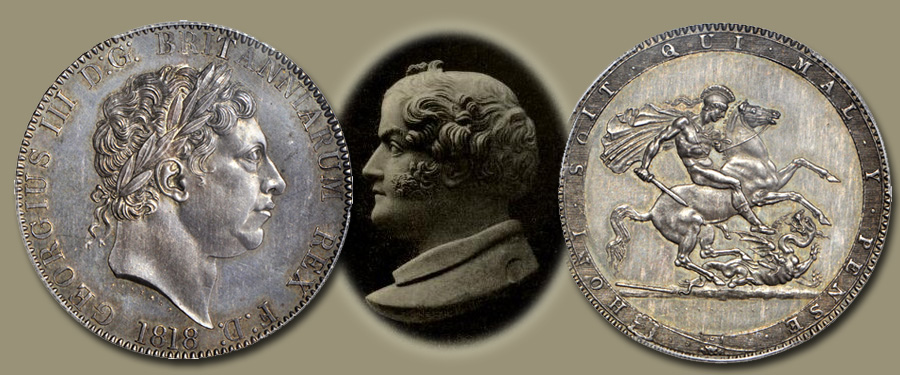
The Stack’s Bowers Galleries January New York International sale is a magnificent event with published high estimates in excess of $9 million.
One of the highlights is lot 20350, a tremendous pattern crown for Great Britain’s
George III engraved by the master Benedetto Pistrucci. L. Forrer author of
“Biographical Dictionary of Medallists” London 1909 vol. IV pg.
589-591, was supplied extensive documentation from Pistrucci’s family, namely
Major Serafino Poggioli, husband of his granddaughter. According to Forrer, during
the new coinage manufacture in 1816 Pistrucci was employed at the mint as an
outside assistant. On 22 September 1817 Thomas Wyon died and Pistrucci was
offered the post of chief engraver. Since he was a foreigner this was highly
contested. While at the mint he made a friend by the name of W.R. Hamilton, who
was his staunch defender. Pistrucci performed his duties as chief engraver,
though the office was kept in abeyance at least until 1828 when a compromise
was made. The second engraver at the mint, William Wyon, was made chief engraver
and Pistrucci was designated as “chief medalist”. Among his opponents
were Mr. Hawkins, the keeper of coins and antiquities at the British Museum,
and Nicholas Carlisle, secretary of the Society of Antiquaries. The latter
practically accused Pistrucci of extorting money from the master of the mint.
Of course this was refuted by Mr. Hamilton who ended his relationship with Mr.
Carlisle. In a letter from W.D. Haggard to Mr. Carlisle that was in the
possession (as of 1909) of Messrs. Spink & Son Ltd. occurs the passage
“Wyon could no more cut the beautiful gem in which Pistrucci excels than
could Pistrucci engrave dies equal in beauty to those of Wyon.” Hawkins
further stated that “Pistrucci’s work is beautifully executed, and its
appearance was hailed with pleasure, and with the hope, that those who were in
authority were weaning themselves from their attachment to armorial bearings,
and becoming alive to the beauty, interest, and importance of classical reverse.”
The obverse design features larger lettering in the obverse legend and the
back of the truncation is chamfered sharply. The reverse differs from the
standard type with fine horizontal lines within the garter. Obverse: “GEORGIUS
III D: G: BRITANNIARUM REX F: D: 1818” (George III By the Grace of God, of
Britain, King, Defender of the Faith) Laureate head of King George III facing
right, “Pistrucci” below bust; Reverse: “HONI . SOIT . QUI . MAL
. Y . PENSE .” (Evil to him who evil thinks) Saint George and the Dragon,
the ground line occupies the whole space between the garters that surrounds the
design, garter ruled with fine horizontal lines, “Pistrucci” in
exergue. Edge: “DECUS ET TUTAMEN ANNO REGNI LVIII” (An ornament and a
safeguard, in the 58th year of our reign) in raised letters with rose stops. It
is clear that the present specimen is truly a work of art with impressive
style, execution and is a testament to Pistrucci’s artistic ability. Lovely
deep old cabinet tone throughout displays hints of blue, red and golden hues
when tilted in the light. This is an important offering of a magnificent
Pistrucci pattern.
While we are no longer taking consignments for our January 2018 New York
International Auction, we are taking consignments of world and ancient coins as
well as world paper money for the upcoming May 2018 Collector’s Choice Online
Auction and the August 2018 ANA World’s Fair of Money Auction in Philadelphia.
We are also accepting consignments of Chinese and other Asian coins and
currency for our April 2018 Hong Kong Showcase Auction. If you are interested
in consigning your coins and paper currency (whether a whole collection or a
single rarity) be sure to contact one of our consignment directors.





